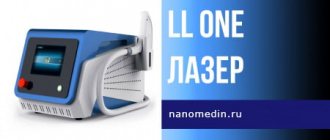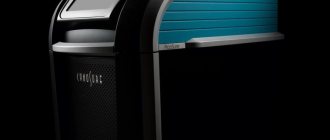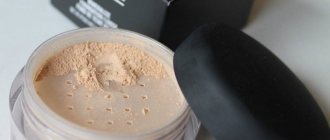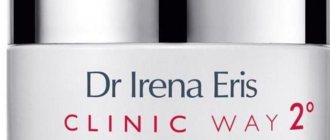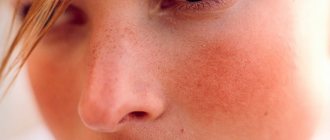What questions to ask the medical staff
A conversation with medical staff allows you to find out as much information as possible before the procedure.
First, find out what services the doctor provides. There are narrower specializations in cosmetology.
A person practicing chemical peeling or mesotherapy should not perform tattoo removal procedures unless he has the appropriate education certificate.
The master must tell and show:
- How will the procedure take place?
- What materials will be used;
- What drugs are used to reduce pain.
You should learn about possible complications, side effects, and guarantees.
Disadvantages of neodymium laser
Among the large number of advantages and versatility of using a neodymium laser in cosmetology, several disadvantages can also be identified. Thus, many patients report increased pain from the procedure. And this is quite normal, since the laser beam of a neodymium device penetrates quite deeply under the skin (up to 8 mm), which can lead to discomfort, especially if a person has too low a pain threshold.
The disadvantages also include that the first results after hair removal with a neodymium laser can only be seen after two weeks. During this time, the hair follicle gradually dies and only then does the process of falling off begin. To achieve the desired result, it is worth taking more than one course of laser treatment, which naturally is not cheap.
Tattoo removal procedure: what should you be concerned about?
A properly configured device will not be able to cause burns, which will then become scars. After the procedure, only redness and swelling may appear. They will disappear in a few days.
The fact that the procedure did not harm the skin can be determined by several signs:
- Changed tattoo color;
- The appearance of redness and slight swelling a few minutes after the session.
After the procedure, the pattern will gradually fade over the course of 4-6 weeks. There should be no wounds or blisters on the skin.
Not all lasers are completely safe. Ruby or alexandrite are much more difficult to adjust; after using them, burns and scars are more likely to occur.
The whole truth about lasers for tattoo removal
“The laser has a great future.
It is difficult to predict where and how it will be used,
but I think the laser is a whole technological era. »
Louis de Broglie
It is difficult to imagine the modern world without the use of laser technologies. More than half a century has passed since the creation of the world's first laser, the ruby laser. Soon other lasers appeared and are widely used in medicine, the military, engineering, space technology, physics and cosmetology. Cosmetology, like the field of beauty, is becoming increasingly popular among people of different ages, gender, and skin color. And this popularity forces us to improve laser technologies to satisfy even the most demanding tastes.
Among all the variety of lasers and ubiquitous advertising, it is very difficult to figure out which laser will be ideal for hair removal, for removing blood vessels, or for removing tattoos. Today, the neodymium nanopulse (Q-switch) laser is recognized as the best for tattoo removal. Is it so? Let's try to find out.
Today, ruby, alexandrite, diode and neodymium lasers are used to remove tattoos.
The ruby laser is the oldest of all existing ones. Opened in 1960 physicist T. Maiman. Generates a monochromatic coherent beam with a wavelength of 694 nm, which corresponds to the red range of the spectrum, at the maximum absorption by melanin. The depth of penetration of the beam into the skin is 1 mm, which does not allow it to affect the deep pigment of tattoos. Hemoglobin is weakly absorbed at this wavelength. Produces light pulses with a duration of about 3 ms, a frequency of 1 Hz, providing an energy flow of up to 40 J/cm2. The low speed and millisecond mode of operation strongly heats non-target objects, since the ruby ray is primarily strongly absorbed by the melanin of the skin, which leads to severe burns, the formation of rough scars and scars, and hypopigmentation. For this reason, it cannot be used to remove permanent makeup. Only works on white skin. In addition, this laser only distinguishes dark colors, black, gray, blue, green, located very superficially in the skin. He is powerless to all warm shades and does not see red at all. Why? From a school physics course we know that a beam with a certain wavelength absorbs all the colors of the spectrum except its wavelength. Any shades of red generate radiation corresponding to the red part of the spectrum.
An Alexandrite laser with a wavelength of 755 nm is an order of magnitude higher than its ruby predecessor - this is already in the near-infrared range of the spectrum. It is faster, operates at a frequency of up to 1.5 Hz, with a pulse duration of up to 300 ms and an energy of up to 40 J/cm2. The depth of penetration into the skin is up to 1.8 mm, which also does not allow reaching deep-lying tattoos. Maximum absorption by melanin, which limits its scope of application to phototypes I and II. Otherwise, it is completely similar to the ruby laser, it works only with dark shades, and is practically powerless in front of warm shades and red. The millisecond operating mode damages not only the tattoo pigment, but also the surrounding tissues with all the ensuing consequences - burns, scars, hypopigmentation.
Diode laser , the “gold standard” of hair removal, is completely unsuitable for tattoo and permanent tattoo removal. This is already a fairly deep laser, with a wavelength of 810 nm, a frequency of up to 10 Hz and a pulse duration of up to 400 ms. The depth of penetration into the skin is 2-3mm. The power can be adjusted up to 100 J/cm2, which makes the diode laser a formidable weapon in the hands of an inexperienced specialist. At a power of up to 40 J/cm2, the principle of selective photothermolysis is still observed in the maximum absorption by melanin; with increasing power, the principle of selectivity is lost and the vessels and surrounding tissues are damaged. When a laser beam hits a tattoo, a deep burn immediately forms, and the darker the pigment of the tattoo, the deeper and more serious the damage. Further in this place there is a change in skin relief (indentations on the skin), keloid scars, scars, hypopigmentation. The situation can be corrected no earlier than 6 months after laser exposure - laser skin resurfacing along the scar. Even if there are those who want to quickly remove a tattoo with a diode laser and subsequently restore the skin texture, removing tattoos with a diode laser is completely impossible.
And finally, let's look at the action of a nanosecond neodymium laser .
Its main difference from all other lasers is the generation of pulses in a nanosecond mode from 0.3 to 0.8 ns, a huge difference in the duration of the beam on the skin compared to millisecond lasers (1 ms = 1/1000 s; 1 ns = 1/1000000000 s). This ultra-short exposure mode allows you to safely remove permanent makeup and tattoos from any part of the body. Since the neodymium laser generates a wave of 1064 nm, the maximum absorption occurs in oxyhemoglobin and deoxyhemoglobin, then in collagen, elastin (which allows this laser to be used for lifting facial skin), water and melanin. This unique property of the neodymium laser allows it to work on all skin phototypes without leaving spots, burns, scars or scars. This is the deepest of all existing lasers, penetrating the skin to a depth of 4-6mm, which allows you to deal with any tattoos. Using a special filter allows you to obtain a green beam with a wavelength of 532 nm based on a neodymium laser - it perfectly brings out all warm colors, including red, and also removes pigmentation on the skin (freckles). The 1064nm infrared beam allows you to safely work on all dark colors of tattoos. The principle of operation is simple: the laser beam is absorbed by the tattoo pigment and splits it into smaller particles, which are removed from the body through the lymphatic system. Already after the first exposure, a noticeable lightening of the tattoo pigment is observed, and the eyelid tattoo is removed in one procedure. The duration of a nanosecond pulse is not enough to damage healthy skin, so the neodymium Q-switch laser is rightfully considered the “gold standard” for removing tattoos of all colors from all skin phototypes.
Despite the uniqueness of the neodymium laser, there are contraindications for tattoo removal:
- Fresh tan (at least 4 weeks must pass after natural tanning or visiting a solarium);
- Photosensitivity (hypersensitivity to sunlight, sun allergy);
- Taking drugs classified as photosensitizers. These are hormonal contraceptives, tetracycline antibiotics, retinoids, sulfonamides . Their use must be stopped 2-4 weeks before your visit to the cosmetology center. It is also worth excluding cosmetic products that contain citrus fruits and bergamot essential oils;
- Taking vitamin A and isotretinoin for the previous six months;
- Skin diseases (atopic dermatitis, eczema, psoriasis, lichen ruber, porphyria and others);
- Unhealed wounds or scratches on the skin;
- Acute infectious diseases (the procedure is taboo even in case of exacerbation of herpes viral infection);
- Decompensated stages of diabetes mellitus ;
- Arrhythmia, severe hypertension, coronary heart disease;
- Mental illness;
- Epilepsy;
- Varicose veins or thrombophlebitis occurring in the laser impact area;
- Malignant formations;
- “golden threads” in the procedure area
- Availability of acoustic, electrical, metal prostheses, implants , “pacemaker” (artificial heart rate driver);
- Tendency to form keloid scars ;
- Reduced blood clotting or increased fragility of blood vessels.
Subtleties of tattoo removal
- The easiest way to remove tattoos is in the chest area, on the arms and legs, and buttocks, and on white skin they disappear the fastest.
- On the fingers, as well as in other places where the amount of fatty tissue is minimal, laser tattoo removal takes longer.
- Drawings that were applied to the skin decades ago are easier to remove than modern ones applied in recent years.
- Paint color matters a lot. Flesh tones are almost impossible to remove with a laser. Dark colors are the easiest to remove. It is also problematic to remove “burnt” paint, which was used several decades ago due to the lack of high-quality paint. It was made from soot and cologne. Paints based on metal oxides are similarly difficult to remove.
- Modern complex designs require lengthy removal. The reason for this is the intricacy of the design and the durability of the ink.
Subtleties of permanent makeup removal
- Sometimes warm shades become darker after laser exposure.
- Laser tattoo removal in one session is only possible from the eyelids, because the depth of pigment penetration in this area is small, and the amount of dye is insignificant.
- The process of laser tattoo removal of eyebrows is longer and more labor-intensive, as is a similar procedure on the lips. This is explained by the depth of the pigment and the use of warm tones.
- After removing permanent makeup, you can use it again after a few months.
- If you camouflage unnecessary areas with flesh tones, you will no longer be able to use the laser in the future. All skin tones (especially white) contain titanium oxide. The laser beam simply does not see it!
- Laser removal of eyebrow tattoos necessarily leads to discoloration of the hairs. But eyebrow growth is stimulated - a nice bonus when removing eyebrow tattoos. Eyebrow color is restored along with the growth of new hairs.
- The swelling in the eyelids goes away on about the third day.
- When the skin is healing after laser removal of permanent makeup, you are allowed to use decorative cosmetics.
Selection of neodymium devices MEDICALASER
Types of procedures that are performed using MEDICALASER neodymium laser devices:
• tattoo removal (color and black and white);
• removal of permanent makeup (eyebrows, arrows, lips);
• removal of pigmentation;
• removal of nail fungus (onychomycosis);
• carbon peeling
Installment plan 0-12-50: terms of installment plan
How to care for the treated area after tattoo removal:
After laser or tattoo removal, you must use special gels and creams (Panthenol spray, Pantestin-gel, Bepanten+, Olazol spray, Solcoseryl, Eganokhil) every day for 5-6 days.
- 7-10 days after laser exposure to the skin, you should avoid visits to baths and saunas, gyms, massage rooms, and it is also not recommended to take hot baths.
- To avoid hyperpigmentation (darkening of areas treated with laser), it is necessary to protect the skin from direct sunlight for 1.5 months. Sunscreens with maximum radiation protection do a good job of accomplishing this task. Another tip: the best time to remove drawings with a laser is the cold season.
- Increasing the amount of water consumed will help speed up the process of removing coloring pigment through the lymph. Daily dose – 8-10 glasses.
IMPORTANT!
Complete removal of permanent makeup can take 3-4 sessions (except for permanent eyelids). You can achieve bleaching of amateur tattoos in 1-4 sessions with a break between them of 6 weeks. Professional drawings are completed in 6-10 sessions with pauses between procedures of 6-8 weeks.
And remember: tattoos and permanent makeup done less than 2 months ago are prohibited from being removed!
Komarnitskaya Natalya
Dermatocosmetologist
Why did the tattoo darken after laser removal?
It happens that after laser removal the tattoo darkens. The color of the pigment after the procedure may become even more saturated and dark - this is normal. A good master first conducts a consultation where he explains everything in detail, and then starts breeding.
The first reason that a tattoo acquires a dark color and even turns black is trauma to the skin during the procedure. The dark color is due to the presence of a specific hematoma. Usually this phenomenon goes away within 14 days from the date of the procedure.
The second reason is the pigments used. For permanent makeup, paints made from warm and cold components are often used. The first ones are displayed in 1-2 sessions, the second ones in 3-6. After the first procedure, black, gray and dark blue pigments remain under the skin, which were previously mixed with red and gave a burgundy or brown tint.
Advantages of a neodymium laser
Neodymium laser is widely used in cosmetology due to its versatility.
Advantages of using neodymium laser in cosmetology:
- removal of unwanted hair
- reduction in the appearance of age spots, regardless of origin
- for inflammatory processes on the skin and during the post-acne period
- tattoo removal or permanent makeup correction
- skin rejuvenation
- possibility of carrying out procedures regardless of skin or hair color type
- it is possible to carry out procedures even in the summer (while other laser systems, when performing manipulations in the summer, can lead to burns, since the depth of their beams is insignificant)
- safety, painlessness and speed of manipulation (the neodymium laser procedure is carried out quickly)
- does not require special care after exposure to the skin and complications such as burns on the skin rarely occur
What can influence the mixing effect?
The results of laser tattoo removal can be affected by many factors:
- Pigment. Black comes out the easiest. Removing bright colors (blue, green, red) is more difficult;
- Location. During tattoo removal, a beam penetrates the skin and breaks the ink pigments into small particles, which are removed by the immune system. The elimination process occurs differently in different zones. The hardest tattoos to remove are on the foot, leg and thigh;
- Overlapping paint, making removal difficult. The laser beam removes pigment layer by layer, so the more pigment in the skin, the more removal procedures there will be;
- Tattoo quality. It is difficult to produce professional drawings; their paint penetration density is greater. After such tattoos, sometimes vague outlines remain. When removing an amateur tattoo, some parts lighten faster, others require several more procedures;
- Intervals between sessions. They must be large enough to allow the skin to recover before the next procedure;
- Doctor's qualifications;
- Corrections. Tattoos often need correction due to loss of color. The more corrections there were, the more procedures will be needed before the tattoo is completely removed.
To achieve a positive effect from laser tattoo removal, you should listen to the recommendations and advice of your doctor. Only then can you expect a positive effect.
Operating principle of neodymium laser
Neodymium laser has been found effective in removing unwanted body hair by the American FDA. This device can also be used to remove body hair in the summer, unlike other laser devices. A distinctive feature of a neodymium laser is the depth of beam penetration (up to 8 mm). Compared to other laser devices, it penetrates deep into tissue without touching the skin.
As a result of deep laser action, not only hair follicles, tattoos and permanent makeup are removed, but also the effect of skin tightening, wrinkle smoothing and rejuvenation is achieved.
The wavelength when working with a neodymium laser is selected individually. The laser beam is converted into thermal energy, thermally affects a specific point or cell, “killing” the hair follicle.
The procedure for applying the device to a person’s subcutaneous tissue is also called non-habilitation rejuvenation, since this thermal effect stimulates the production of collagen. Due to this, the skin tightens, becomes elastic and smooth.
Neodymium laser can also be used for vascular pathologies. The capillary, venous or arterial mesh is removed under the influence of a laser beam. In this case, the action of the device is targeted and healthy tissues are not affected.
As an additional and effective procedure, a neodymium laser can be used to treat acne, post-acne or various inflammations and rashes on the skin. With the help of deep exposure to a laser beam, scars are removed, and the skin becomes more elastic.
Also, a neodymium laser effectively and without consequences copes with the removal of tattoos, regardless of the pigment. Since sometimes, when amateurishly applying a pattern to the body, the pigment penetrates quite deeply, it can only be removed with the help of this device. No other laser device removes tattoos or permanent makeup so well.
Tips from dermatologists for skin care after the procedure
After the laser, redness and swelling may remain on the surface of the skin, which disappear within 1-3 days. If a crust appears, you cannot touch it. It will disappear on its own in 3-6 days.
At the end of the session, the doctor applies an ointment, usually Bepanten or analogues. The ointment should be applied three times a day for 3 days. Apply Bepanten ointment to the affected area so that it does not itch and there is no tightening.
Avoid exposing your skin to sunlight for 14 days, and avoid going to the swimming pool, sauna or bathhouse.
Kes Med 810A
This device operates at high frequencies. By installing the laser into the tattoo area, black and blue melanin can be removed. The technical characteristics of the device are designed in such a way that the device does not cause pain and does not provoke allergic reactions. The session takes place in safe mode.
The device is designed for transportation due to its small dimensions. It can be used both in the salon and at the client’s home. The device effectively copes not only with tattoos, but also with other tasks:
- Eliminates unwanted pigmentation in the face and entire body
- Fights vascular dilations. Before the procedure, you must consult a doctor
- Elimination of unwanted vegetation
- Carrying out a carbon peeling session
- Eliminate a permanent
- Freckle removal
The laser device penetrates into the deep layers of the patient's skin. Heat is responsible for breaking down the skin at the cellular level.
This neodymium laser is not cheap, starting from 200,000 rubles, but the quality of the products from this Beijing factory is impeccable.
ADSS RY-580
The cost of this solid-state neodymium laser device is 250,000 rubles. This device effectively removes tattoos and permanent tattoos.
The set includes two attachments:
- 1064 nanometers (for dark pigment removal)
- 532 nanometers (for light pigment removal)
Range of use of this device:
- Tattoo removal
- Scar smoothing
- Removing pigment spots
- Elimination of melanin formations on the skin
RY-580 has no side effects and acts exclusively on problem areas without spreading to nearby tissues. During the operation of the device and after the procedure, there is no need to use any medications. Description:
- The weight of the equipment is 31 kilograms
- Dimensions - 60 × 32 × 35 centimeters
- Water-air cooling system
- Power is 1600 mJ
